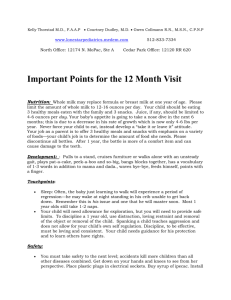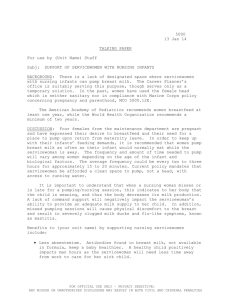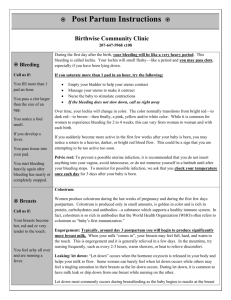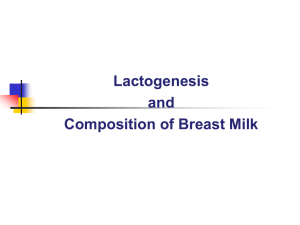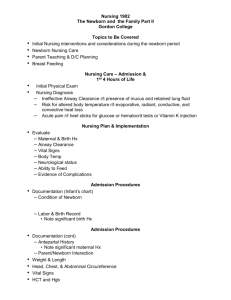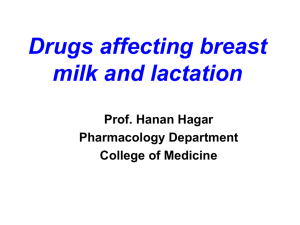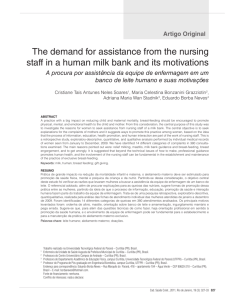Methodical Breastfee
advertisement
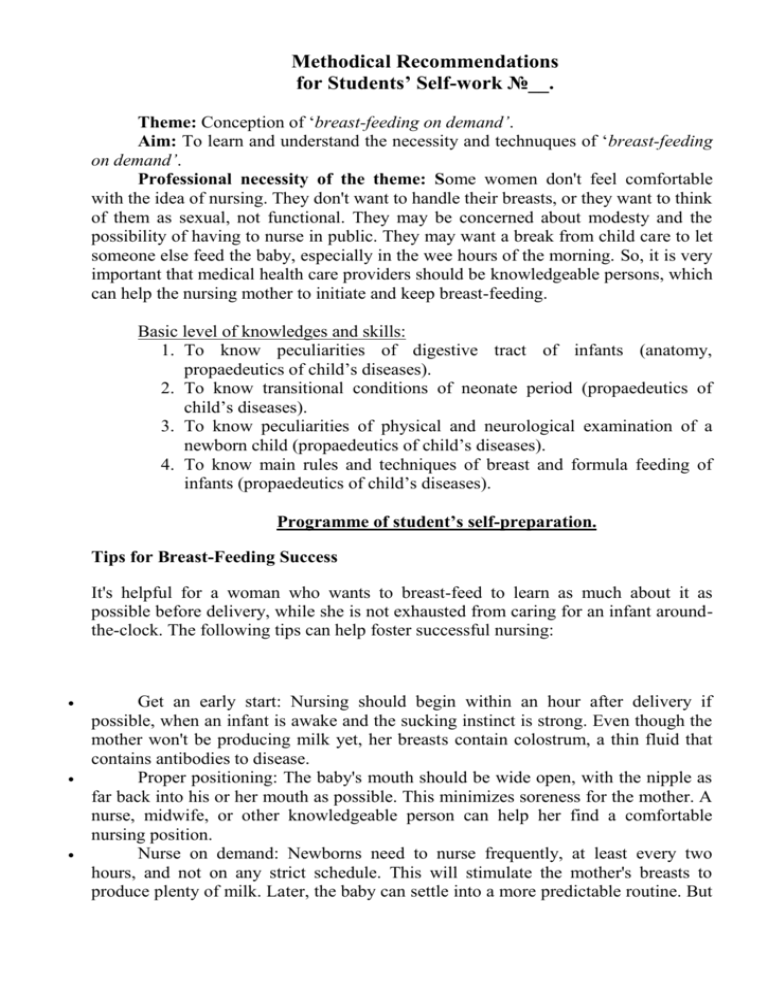
Methodical Recommendations for Students’ Self-work №__. Theme: Conception of ‘breast-feeding on demand’. Aim: To learn and understand the necessity and technuques of ‘breast-feeding on demand’. Professional necessity of the theme: Some women don't feel comfortable with the idea of nursing. They don't want to handle their breasts, or they want to think of them as sexual, not functional. They may be concerned about modesty and the possibility of having to nurse in public. They may want a break from child care to let someone else feed the baby, especially in the wee hours of the morning. So, it is very important that medical health care providers should be knowledgeable persons, which can help the nursing mother to initiate and keep breast-feeding. Basic level of knowledges and skills: 1. To know peculiarities of digestive tract of infants (anatomy, propaedeutics of child’s diseases). 2. To know transitional conditions of neonate period (propaedeutics of child’s diseases). 3. To know peculiarities of physical and neurological examination of a newborn child (propaedeutics of child’s diseases). 4. To know main rules and techniques of breast and formula feeding of infants (propaedeutics of child’s diseases). Programme of student’s self-preparation. Tips for Breast-Feeding Success It's helpful for a woman who wants to breast-feed to learn as much about it as possible before delivery, while she is not exhausted from caring for an infant aroundthe-clock. The following tips can help foster successful nursing: Get an early start: Nursing should begin within an hour after delivery if possible, when an infant is awake and the sucking instinct is strong. Even though the mother won't be producing milk yet, her breasts contain colostrum, a thin fluid that contains antibodies to disease. Proper positioning: The baby's mouth should be wide open, with the nipple as far back into his or her mouth as possible. This minimizes soreness for the mother. A nurse, midwife, or other knowledgeable person can help her find a comfortable nursing position. Nurse on demand: Newborns need to nurse frequently, at least every two hours, and not on any strict schedule. This will stimulate the mother's breasts to produce plenty of milk. Later, the baby can settle into a more predictable routine. But because breast milk is more easily digested than formula, breast-fed babies often eat more frequently than bottle-fed babies. No supplements: Nursing babies don't need sugar water or formula supplements. These may interfere with their appetite for nursing, which can lead to a diminished milk supply. The more the baby nurses, the more milk the mother will produce. Delay artificial nipples: It's best to wait a week or two before introducing a pacifier, so that the baby doesn't get confused. Artificial nipples require a different sucking action than real ones. Sucking at a bottle could also confuse some babies in the early days. They, too, are learning how to breast-feed. Air dry: In the early postpartum period or until her nipples toughen, the mother should air dry them after each nursing to prevent them from cracking, which can lead to infection. If her nipples do crack, the mother can coat them with breast milk or other natural moisturizers to help them heal. Vitamin E oil and lanolin are commonly used, although some babies may have allergic reactions to them. Proper positioning at the breast can help prevent sore nipples. If the mother's very sore, the baby may not have the nipple far enough back in his or her mouth. Watch for infection: Symptoms of breast infection include fever and painful lumps and redness in the breast. These require immediate medical attention. Expect engorgement: A new mother usually produces lots of milk, making her breasts big, hard and painful for a few days. To relieve this engorgement, she should feed the baby frequently and on demand until her body adjusts and produces only what the baby needs. In the meantime, the mother can take over-the-counter pain relievers, apply warm, wet compresses to her breasts, and take warm baths to relieve the pain. Eat right, get rest: To produce plenty of good milk, the nursing mother needs a balanced diet that includes 500 extra calories a day and six to eight glasses of fluid. She should also rest as much as possible to prevent breast infections, which are aggravated by fatigue. References 1. Committee on Nutrition: Nutritional needs of low-birth-weight infants. PEDIATRICS, 60:519, 1977. 2. Ziegler, E.E., Biga, R.L., and Fomon, S.J.: Nutritional requirements of the premature infant. In Suskind, R.M., ed.: Textbook of Pediatric Nutrition. New York: Raven Press, pp. 29-39, Textbook of Pediatric Nutrition. New York: Raven Press, pp. 29-39, 1981. 3. Reichman, B., Chessex, P., Putet, G., Verellen, G., Smith, J.M., Heim, T., and Swyer, P.R.: Diet, fat accretion, and growth in premature infants. New Engl. J. Med., 305:1495, 1981. 4. Gordon, H.H., Levine, S.Z., and McNamara, H.: Feeding of premature infants. A comparison of human and cow's milk. Amer. J. Dis. Child., 73:442, 1947. 5. Gaull, G.E., Rassin, D.K., Raiha, N.C.R., and Heinonen, K.: Milk protein quantity and quality in low-birth-weight infants. III. Effects on sulfur ammo acids in plasma and urine. J. Pediat, 90:348, 1977. 6. Raiha, N.C.R., Heinonen, K., Rassin, D.K., and Gaull, G.E.: Milk protein quantity and quality of low-birthweight infants. I. Metabolic responses and effects on growth. PEDIATRICS, 57:659, 1976. 7. Fomon, S.J., Ziegler, E.E., and Vazquez, H.D.: Human milk and the small premature infant. Amer. J. Dis. Child. 131:463, 1977.

